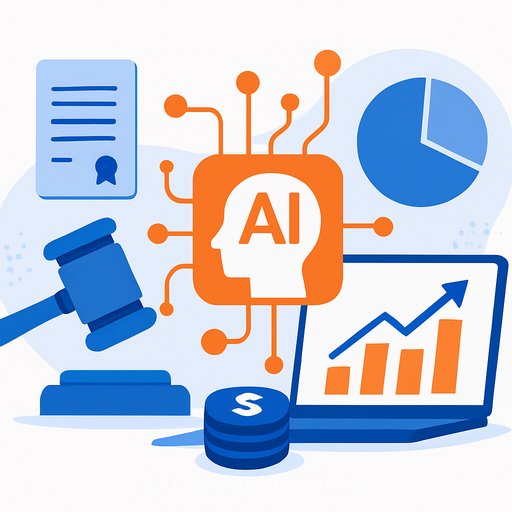SB 53 Proves State AI Law Can Support Innovation: A Legal Playbook for Counsel
California's SB 53, signed into law this week, shows that state AI regulation can protect innovation while raising the bar on safety. That's the core message from Adam Billen, public policy lead at Encode AI, who argues the law locks in practices many large labs already claim to follow.
His view is blunt: policy can prevent safety backsliding under competitive or financial pressure. "There is a way to pass legislation that genuinely does protect innovation while making sure that these products are safe," he said.
What SB 53 Actually Requires
- Transparency: Large AI developers must document safety and security protocols, with emphasis on preventing catastrophic misuse (e.g., cyberattacks on critical infrastructure or bio-weapon development).
- Adherence: Companies must follow the protocols they publish; this isn't performative disclosure.
- Enforcement: The California Office of Emergency Services will oversee compliance and enforce obligations. See Cal OES.
Many labs already conduct safety testing and publish model cards. The bill formalizes these commitments so they can't be relaxed when a competitor ships a risky system.
Why This Matters for Legal Teams
SB 53 will be cited in negotiations, audits, and incident reviews. If you advise an AI lab-or contract with one-treat these obligations like any other safety-critical compliance regime.
- Scope analysis: Determine if your client qualifies as a "large" AI developer under the law's definitions and any forthcoming guidance.
- Protocol governance: Convert public safety claims into internal controls with owners, versioning, and approval workflows.
- Evidence: Maintain testing records, model cards, red-team results, and change logs that tie directly to your public protocols.
- Contracts: Flow down safety obligations to vendors, research partners, and deployment customers; add audit, notification, and cure terms.
- Board oversight: Calendar periodic reviews; document deliberations around risk tolerances and release gates.
- Incident response: Map "catastrophic misuse" scenarios to escalation paths and mandatory communications.
Competition Doesn't Excuse Safety Backsliding
Some labs have signaled they may "adjust" safety standards if rivals ship riskier systems. SB 53 creates a floor that prevents reactive downgrades.
Action for counsel: eliminate clauses that let competitive events trigger safety exceptions. If exceptions are truly necessary, require defined criteria, executive sign-off, and public disclosure aligned with the statute.
The Preemption Push to Watch in D.C.
A federal preemption effort is building. The SANDBOX Act would allow AI companies to secure waivers from certain federal rules for up to 10 years. Expect proposals for a federal "AI standard" framed as compromise but written to override state laws.
Billen's warning: a narrow federal bill could "delete federalism for the most important technology of our time." For state-focused regimes on deepfakes, transparency, algorithmic bias, child safety, and government AI, a broad preemption clause would matter more than any single requirement.
What About the U.S.-China AI Race?
Billen argues bills like SB 53 won't decide geopolitical outcomes. If the priority is competing with China, you'd focus on export controls and chip access-areas already shaped by federal moves like the CHIPS and Science Act.
He notes industry resistance to certain controls, plus mixed federal signals on chip exports. Meanwhile, industry groups have pushed moratoriums that would block states from acting at all-efforts that continue in different forms.
Action Checklist for Legal Teams
- Inventory public safety claims; map each claim to a tested internal control and an artifact proving adherence.
- Stand up a release governance memo: sign-offs, red-team thresholds, rollback criteria, and post-release monitoring.
- Draft a "no-competitive-downgrade" policy and remove any release triggers tied to competitor launches.
- Update vendor/MSA templates with safety flow-downs, audit rights, incident notice, and termination for non-compliance.
- Establish a records plan: retention, versioning, and reproducibility across model iterations.
- Brief the board on SB 53 exposure and the federal preemption risk; track the SANDBOX Act and related proposals.
- Coordinate with government affairs on comment opportunities if rulemaking or guidance follows.
What This Signals for Future State AI Bills
SB 53 shows statehouses can pass targeted, enforceable rules without choking off development. Expect more narrow bills on deepfakes, transparency, bias audits, and agency use of AI-especially where existing safety claims are easy to codify.
For counsel, the strategy is simple: treat public promises as binding, build the audit trail now, and assume state oversight will keep expanding where industry already says it has guardrails.
Optional Resource
If your team needs structured upskilling on AI, compliance, or deployment risk, see role-based options here: AI courses by job.
Your membership also unlocks:






